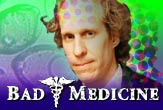Suffocating Trends: Oxygen Bars and Drinks

Don't get me wrong. I like oxygen. I breathe in my share every day. Nevertheless I remain skeptical of new products designed to put more oxygen into my body. Marketers of oxygenated bottled water and oxygen bars are breathing down my neck.
Actor and noted hemp enthusiast Woody Harrelson opened an oxygen bar in Hollywood a few years ago, where you pay a premium to breathe in the good stuff. I know what you're thinking: "Woody Harrelson! I loved him as a bald-headed mass-murderer in 'Natural Born Killers.' Surely he knows a thing or two about my respiratory system."
Well, believe it or not, Woody might be a little off this time.
Ludicrous idea
The notion that we need extra oxygen is ludicrous. The human body has adapted quite well to this lower atmosphere of ours that is roughly 21 percent oxygen, 78 percent nitrogen and 1 percent trace gases. Blood cells, on exiting the lungs, are nearly saturated with about 97 percent oxygen bound molecularly to hemoglobin. Getting more oxygen serves no purpose. In fact, it's a bad thing.
Deep in the lungs, tiny and fragile sacs called alveoli are the site where inhaled oxygen enters the bloodstream and carbon dioxide leaves to be exhaled. With a surplus of oxygen in the lungs, the carbon dioxide can't leave the body. Worse, the build up of oxygen in the lungs can collapse the alveoli and cause permanent lung damage. Adults with emphysema, chronic asthma or chronic bronchitis, in particular, will stop breathing if they inhale pure oxygen for too long. Premature babies, given extra oxygen because their lungs aren't sufficiently mature to transfer oxygen into the blood, can go blind if the concentration gets too high, a malady called retinopathy of prematurity; that's likely what happened to Stevie Wonder.
Also, oxygen may be what ultimately kills you, rusting your body from the inside in a process called oxidation and free-radical production. Breathing pure oxygen creates an abundance of free radicals.
Sign up for the Live Science daily newsletter now
Get the world’s most fascinating discoveries delivered straight to your inbox.
Unfortunately the world of alternative medicine has painted a scenario in which the human body is oxygen-deprived. More oxygen will remove toxins and even cure cancer, many in this community argue. This is a persuasive argument in this age of industrial pollution, but this goes against basic biology.
Oxygen doesn't cure; and we aren't lacking any.
Mall science
Oxygen bars are now popping up in shopping malls. For the past five years they have been common in trendy clubs in big cities that attract young people hoping to throw away money as quickly as possible. For a few dollars per minute, you can breathe in pure oxygen through a mask or tubes, for that oh-so-sexy emphysema-sufferer look. Sometimes the oxygen is flavored. O2 enthusiasts report clearer thoughts, more energy and other subjective stuff that you can't measure. Then they get drunk.
Oxygenated water, available in bottled water aisles everywhere, is cheaper but equally as dumb.
Aside from the O part in H2O, ordinary water has about 0.5 percent dissolved oxygen gas. This is what fish filter through their gills. Oxygenated water can carry as much as 5 percent oxygen. Now, if we assume that humans absorb oxygen efficiently through their gut, which they don't, and if the dissolved oxygen in the oxygenated water doesn't bubble into the air when you open the bottle and expose it to standard pressure, which it does, how much O2 are you getting?
The math is straightforward. Most oxygenated drinks contain no more than 125 mg/liter; air contains about 250 mg/liter. (Although air is about 20 percent oxygen and the oxygenated water is 5 percent dissolved oxygen, the density is different, so this isn't quite 4:1.) Each minute we inhale about 12 times and breathe in about 4 liters of air. So you need to drink two liters of oxygenated water (at 125 mg/l) just to keep up with three good breaths (about a liter of air).
At a dollar a bottle, you might want to reconsider drinking your oxygen. After all, the air is free ... well, except at Woody's place.
Christopher Wanjek is the author of the books “Bad Medicine” and “Food At Work.” Got a question about Bad Medicine? Email Wanjek. If it’s really bad, he just might answer it in a future column. Bad Medicine appears each Tuesday on LIveScience.
Related Stories
- Human Ears Evolved from Ancient Fish Gills
- Increase in Oxygen Helped Mammals Dominate
- Invention Allows Humans to Breathe Like Fish
More Bad Medicine
- Few Clues to High IQs
- Licensed to Kill: Some Doctors are Real Naturals
- War on Bacteria is Wrongheaded
- Soda Sales Go Flat, Industry Fights Back
- Go Ahead, Drink Bacon Grease for Breakfast

Christopher Wanjek is a Live Science contributor and a health and science writer. He is the author of three science books: Spacefarers (2020), Food at Work (2005) and Bad Medicine (2003). His "Food at Work" book and project, concerning workers' health, safety and productivity, was commissioned by the U.N.'s International Labor Organization. For Live Science, Christopher covers public health, nutrition and biology, and he has written extensively for The Washington Post and Sky & Telescope among others, as well as for the NASA Goddard Space Flight Center, where he was a senior writer. Christopher holds a Master of Health degree from Harvard School of Public Health and a degree in journalism from Temple University.










